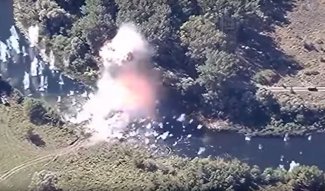Russians counterattack in Kursk Oblast. Day 936 of the war


On 10 September, the Russians struck the left flank of Ukrainian forces in Kursk Oblast, pushing them back from Korenevo and restoring the overland connection with the southern part of the Glushkovo District (previously they had been dependent on the crossing of the Seim River, which had been systematically destroyed by the Ukrainians). Over the next few days they regained control of about 20% of the territory seized by Ukrainian forces in August and approached their main line of communication. On 11 September, the Ukrainians led a counterattack, entering Russian territory towards Glushkovo, presumably with the intention of heading towards the rear of the attacking Russian troops. So far, however, they have been unsuccessful and fighting has stalled in the area of the village of Veseloye, located 3km from the border. Russian forces also became active in the Sudzha area, but it was not until 16 September that information emerged about the expulsion of Ukrainian forces from the border areas of Sudzha and Belaya Districts, south-east of Sudzha. On 16 September, Ukrainian military intelligence (HUR) estimated the size of the Russian grouping in the Kursk region at 38,000 troops.
The Pokrovsk area saw a relative stabilisation of the front line. Ukrainian forces re-entered the villages of Krasnyi Yar and Krutyi Yar south of Myrnohrad, leading to renewed fighting over them. On 12 September, Russian forces destroyed the viaduct linking Pokrovsk and Myrnohrad, with the biggest problem being its collapse onto the railway line from Pokrovsk to the north of the Donetsk region, which will at least temporarily hamper the supply of Ukrainian units fighting there. On 16 September, in turn, substations responsible for supplying Pokrovsk with electricity, gas and water were destroyed.
The Russians are continuing their operations to cut off Vuhledar and the Ukrainian forces remaining in the forks of the Vovcha and Lozova rivers west of Donetsk. They have most likely pushed the defenders out of South Ukrainian Mine No. 3, the last major fortified area north of Vuhledar, and from the central part of the Ukrainsk junction south-east of Selydove. Fighting is continuing for the village of Hostre – the last one east of Kurakhove, to which less than 5 km remains.
Russian forces are advancing towards the centre of Toretsk from the east and have hit the city from the south. Conflicting information is emerging about the situation between Toretsk and Niu-York, on the northern outskirts of which Ukrainian troops are believed to still be holding out. The Russians have crossed the Donets-Donbas canal south of Chasiv Yar and the road leading to Kostiantynivka. According to some sources, the Ukrainians are gradually evacuating their last positions east of the canal – an area they recaptured in the 2023 summer offensive. Russia is steadily expanding the controlled area to the north and south-east of Kupiansk. Less than 4 km is thought to remain to the Oskil River south of the town.

Russian suicide drones continue to destroy the energy infrastructure to Ukraine’s rear. In the frontline regions, it is also one of the main targets of aviation and artillery. Energy facilities in Chernihiv (13 and 16 September), Donetsk (14–16 September), Sumy (11, 13 and 17 September) and Zaporizhzhia (13 September) oblasts were attacked. There was a blackout in the northern part of Donetsk region on 14–15 September, and two large substations were destroyed or severely damaged in the attack on Sumy on 17 September. In the frontline areas, stable energy supplies are now solely provided by generators. In addition, the Russians hit fuel depots near Ivano-Frankivsk (13 September), and Odesa and the surrounding area (13 and 14 September). The intensity of air strikes on Kharkiv remained high – the city was attacked on 12, 14 and 15 September (one civilian was killed and 42 wounded on 15 September). According to Ukrainian data, between the morning of 11 September and the early hours of 17 September, the Russians used 30 rockets (Ukraine claimed it shot down two) and 312 ‘Shaheds’ (257 claimed as intercepted).
On 12 September, a Russian missile damaged a Romanian ship carrying a shipment of Ukrainian wheat for Egypt. Bucharest did not lodge a protest and the Foreign Ministry there stated only that “Russia must stop attacking merchant ships and start respecting the freedom of navigation”. On 16 September, Ukrainian Navy spokesman Dmytro Pletenchuk reported that the ship was outside the 2023 designated grain corridor when it was hit.

On 13 September, Dutch Defence Minister Ruben Brekelmans announced the delivery to Ukraine of a radar for the Patriot air defence system battery, which the Netherlands in May announced it would perform and hand over together with undisclosed partners. According to Brekelmans, three launchers would also be handed over soon. The following day, the NL Times reported that the commitment would not be fulfilled due to one partner refusing to deliver previously pledged components. The Dutch Defence Ministry refused to answer the question of which country was involved. On 16 September, the transfer of the second battery of the SAMP-T air defence system to Ukraine was announced by the Italian Foreign Ministry. The Ukrainians received their first SAMP-T systems from Italy and France in May 2023.
New military support packages were announced by Croatia and Latvia (11 September) and Finland (13 September). Among other things, the Latvians pledged to hand over nine CVR(T) armoured reconnaissance transporters previously acquired from the UK. It is likely that Latvia will eventually hand over all of the 116 CVR(T) it has in service to Ukraine. No information on the contents of the packages was given by Croatia and Finland. Helsinki has only revealed that this is the 25th package of Finnish military aid to Kyiv, and estimates its value at €118 million.
Ukraine has received 18 Bohdana self-propelled howitzers, the production of which was financed by Denmark. This was announced on 15 September by Defence Minister Troels Lund Poulsen. A day later, he announced that more Danish F-16 fighter jets would arrive in Ukraine in the second half of this year. M113 tracked transporters from Lithuania had also arrived there by 15 September.
On 15 September, in an interview with CNN, President Volodymyr Zelensky made another criticism of insufficient military support from Western countries. He stated that Western supplies were not enough to equip ‘even four’ of the fourteen new brigades (being formed after the change in mobilisation legislation).

On 16 September, Vladimir Putin issued a decree to increase the personnel of the Russian Armed Forces from 1 December 2024 to 2,389,000, including 1.5 million military personnel. Plans in this regard were announced by the Russian Defence Ministry in December 2022. However, according to announcements at the time, the ceiling of 1.5 million military personnel was to be reached by 2026. Since the beginning of the full-scale aggression against Ukraine, this is the third decree increasing the military personnel of the Russian Armed Forces. In August 2022, it was increased to 1,150,600 (from the level of 1,013,600 in force since 2017), and in December 2023 it was increased to 1,320,000. Since 2017, civilian personnel have remained constant at 889,000.
The high compensation (by Russian standards) of more than $2,000 a month without taking into account additional one-off payments have so far guaranteed a steady flow of volunteers for military service, and it is estimated that their numbers outnumber the losses incurred. According to Pentagon data, a total of 350,000 Russian soldiers from all formations had been wounded and killed in Ukraine by early July this year. Meanwhile, from autumn 2022 to April 2024, at least 426,000 took up contract service in the Russian Armed Forces (this is according to the Conflict Intelligence Team; the official figure was 640,000). In addition, 300,000 Russians were placed in military service under so-called ‘partial mobilisation’. If the current level of funding and – at the same time – the initiative at the front is maintained (the conviction that Russia is winning the war favours recruitment for service), reaching the ceiling of 1.5 million servicemen by the Russian Armed Forces should be considered likely without the need for another mobilisation.
On 11 September, British television channel Sky News reported that a ship from Iran with Fath-360 ballistic missiles with a range of 120 km arrived at the port of Olya, south of Astrakhan, earlier this month. According to Sky News sources, the country handed over 220 missiles to Russia, which were diverted from the port to the Ashuluk firing range in the Astrakhan region to prepare them for use in Ukraine. According to Kyiv, so far Iranian missiles have not been used in Ukraine. On 16 September, Tehran once again denied reports of arms being transferred to Moscow. Reports of missiles being diverted from Iran to the training ground make it possible to assume that Russia acquired Iranian missiles at least in part for training purposes, analogous to the artillery munitions acquired from North Korea.
On 14 September, the head of Ukraine’s military intelligence service (HUR), General Kyrylo Budanov, assessed that Russia would seek to end the war in Ukraine by the turn of 2025 and 2026. According to Budanov, the Kremlin forecasts that from mid-2025 economic and socio-political problems will accumulate in the Russian Federation, and the government will be forced in parallel to carry out a large wave of mobilisation or to reduce the intensity of combat operations. Budanov calculates that war fatigue, which a significant part of the population has been confronted with, can already be seen in Russia. A manifestation of this is the decline in the number of those willing to enter into a contract with the army, despite an increase in the one-off allowance for signing up to 2 million roubles (approximately $22,000).
In recent days, a scandal involving the revelation of pathologies in the units of the former 1st Donetsk Army Corps (reformed into the 51st Combined Arms Army at the beginning of 2024) has reverberated on Russian social media. Russian military bloggers have published the testimonies of two experienced drone operators from the 87th Rifle Regiment who – in conflict with their superiors – were sent on an assault near Pokrovsk and died. Before their deaths, they accused the commander of their regiment of, among other things, collaborating with the enemy, making false reports about the situation at the front, sabotaging the work of the reconnaissance drone subunit and profiting from drug trafficking among subordinate soldiers. The pre-mortem footage also included warnings not to sign a contract with the army, and in particular with troops originating from the former Donetsk separatists. This scandal is further evidence of the collapse of discipline and morale in the Russian army fighting in Ukraine.
On 17 September, photographs were published on Russian social media showing that Russia has committed another war crime. In the town of Novohrodivka in the Donetsk region, occupied by the Russians in August this year, a Ukrainian prisoner of war was murdered with a sword bearing the inscription “For Kursk”.

On 14 September, Ukrainian volunteer Serhii Sternenko announced that the number of FPV strike drones delivered to the army had exceeded 100,000. Their purchase was funded entirely by public collections, with no state funding. Sternenko is donating FPV drones of various types to the army – from the simplest models used to fight infantry to more complex ones designed to destroy Russian reconnaissance drones or attack helicopters. The activities of the Sternenko community are evidence of the continuing high level of public commitment to the war effort and the innovation of Ukrainian engineers.
On the other hand, the inefficiency of state structures in equipping the army with drones, especially in terms of Mavic or Autel-type FPV and close-range reconnaissance drones, is a serious problem. On 16 September, volunteer Yurii Hudymenko reported that only 50 Mavic 3T drones had been delivered to the army by the Defence Procurement Agency over the past month. The reason for such limited deliveries is said to be the end of existing contracts and a halt in funding. The Mavic 3T is a basic short-range reconnaissance drone with a thermal imaging camera that should be on the equipment of every infantry company. Due to the losses, the monthly requirement for this equipment is estimated to be at least hundreds across the army, and with state purchases on hold, troops are being forced to ask for help from volunteers.






